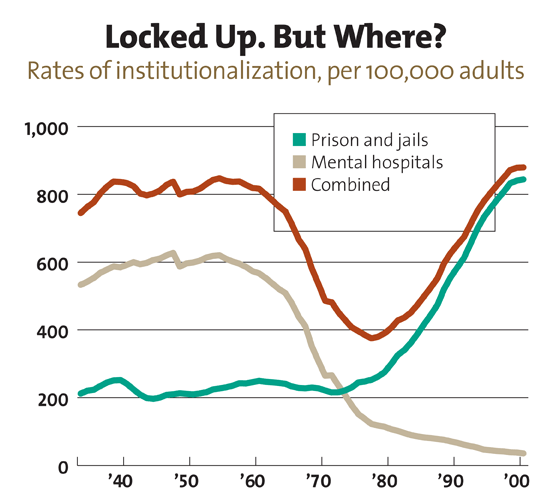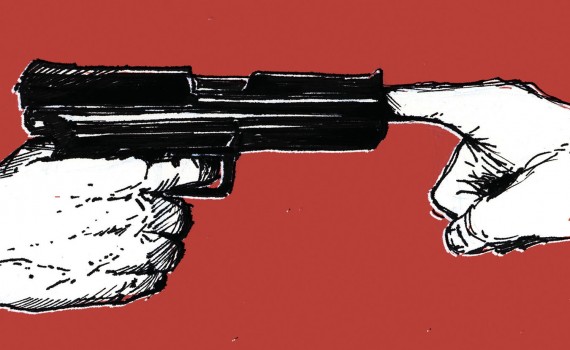How America’s criminal justice system became the country’s mental health system
“I was very delusional, erratic, confrontational, and paranoid,” Kevin said. “So when they came, they tased me.”

courtesy of VOX
by German Lopez published on March 1, 2016 on VOX
“I was very delusional, erratic, confrontational, and paranoid,” Kevin said. “So when they came, they tased me.”

Dear Mr. Earley,
Thank you for your testimony at the Senate Committee on the Judiciary hearing entitled: “Breaking the Cycle: Mental Health and the Justice System”… Attached are additional written follow up questions from Committee members…”
From Chairman Chuck Grassley:
I believe it is uncontested that mental health and mental illness have played at least some, if not the primary role in incidents that are now known by chilling, geographic, monikers such as Virginia Tech, New Town, Aurora, and Roanoke. As the Wall Street Journal reported late last fall, we need to make sure we are getting to these individuals when they are struggling with mental health issues, but before they spiral into full blown crisis.
Given that there are multiple schools of thought on how best to handle the mental health crisis as it relates to mass murders, what do you believe would be the most effective way to keep mentally ill individuals from harming others? Put another way, what can we do to help these ill individuals, but also prevent yet another mass murder?
RESPONSE FOR THE RECORD FROM PETE EARLEY, AUTHOR, JOURNALIST
As the parent of an adult son with a severe mental illness, I cringe whenever I see a news report about someone who is psychotic committing a violent act, such as a mass shooting.
It is important to put these shootings into context.
*Overall, persons with mental illnesses commit only five percent of all crimes. (1.)
*Overall, persons with mental illnesses are more likely to be victims than perpetrators of violence. (2.)
*When it comes to mass shootings, a study found that only 11 percent of mass shootings between 2009 and 2015 involved gunmen suspected of having mental health problems. (3.)

On Friday, 1-29-16, I posted a blog by journalist/author Robert Whitaker questioning the value of anti-psychotic medications. Whitaker felt compelled to explain his position about medications because of statements challenging him made by Dr. Allen J. Frances, Professor Emeritus of Psychiatry and Behavioral Sciences at Duke University Medical School in an email. Here is Dr. Frances’ response to Whitaker’s response.
Do Antipsychotics Help Or Harm Psychotic Symptoms?
By Dr. Allen J. Frances
This is the latest, and perhaps last, of several debates with Bob Whitaker on the role of antipsychotics in treating psychotic symptoms. It was triggered by a recent email exchange that clarified our areas of agreement and disagreement.
Bob and I agree strongly on the following:
1) Antipsychotic medicines are used far too often in people who don’t need them.
2) Even when necessary, doses are often too high and polypharmacy too common.
3) Antipsychotics are neither all good, nor all bad. Used selectively, they are necessary and helpful. They are harmful when used carelessly and excessively.
4) The treatment of people with psychosis relies far too much on medication alone, far too little on social engagement, psychotherapy, vocational rehabilitation, and providing adequate housing. We both like the normalizing, recovery models offered by Trieste, Open Dialogue, and Hearing Voices. (click here to read more on this subject.)
5) The care provided for the mentally ill in the US is a disaster that shames our country. (click here to read my thoughts about this.)
Bob and I disagree strongly on the following:
1) Bob believes that long term use of antipsychotics makes psychotic symptoms worse. He therefore recommends that patients try to avoid antipsychotic medicine altogether or taper off them, whenever possible.

Two women meet, fall in love and become one of the first gay couples to legally marry only to have their lives shattered when they are sexually attacked in their home and one of them is viciously murdered. Incredibly, the survivor in this true life crime story forgives the rapist/murderer. And yes, that man has a mental illness.
The book’s publisher sent me a pre-publication copy of this story because he hoped I would write a “blurb” — one of those gushing quotes printed on book covers to lure buyers. Although the writer did an excellent job explaining how deinstitutionalization and a lack of community mental health services have led to our jails and prisons becoming defacto mental asylums, I declined.
Book blurbs are one or two sentences and I couldn’t write an endorsement in twenty words that explained the perpetrator in this book was not typical. Most persons with mental illnesses are not dangerous. They are not rapists and murderers. They are more likely to be victims rather than committers of crimes.
Yet, here was an example of a mentally disturbed man who was very dangerous and very violent. How do we explain his actions?

Deeds in happier times with his son, Gus.
Before anyone feels sorry for state mental health officials who are being sued by Virginia state Senator Creigh Deeds, they should do what my favorite columnist at The Washington Post has done. Take time to read several blogs that I wrote about an Inspector General report that was issued twenty-two months before Deeds was told there were no local mental health beds available and was sent home with his son, Gus, who desperately needed psychiatric treatment.
A fair-minded but tough state Inspector General named G. Douglas Bevelacqua wrote a damning report in 2012 that exposed how Virginia hospitals were “streeting” psychotic patients. That was the term emergency room doctors used when they turned patients away because there were no crisis care beds available. Bevelacqua, who cared passionately about mental health reform, warned the state’s Department of Behavioral Health and Developmental Services that Virginia had a bed shortage problem that needed to be fixed. Immediately.
No one listened.
After the Deeds’ tragedy, state mental health officials issued a self-serving report that made it sound as if they had paid attention to Bevelacqua’s findings, but simply hadn’t been able to implement his recommendations in time to prevent the Deeds’ tragedy. Bull.
Rather than fessing up, those officials began circling the wagons, so much so, that Bevelacqua resigned in protest, claiming that his boss was pressuring him to water down an investigation of how state mental health officials had bungled the entire “streeting” crisis. His boss, Michael F.A. Morehart subsequently released the report that Bevelacqua had refused to sign and did exactly what Bevelacqua had predicted. His report didn’t take anyone to task for their failure to address “streeting” in time to save Gus Deeds.

The Washington Post has been at the forefront of writing about police involved shooting deaths and last week, reporters Cheryl W. Thompson and Mark Berman cast a much needed spotlight on the use of Tasers. At least one person a week dies in the U.S. after being stunned with a Taser and more than half of them had a mental illness or illegal drugs in their system, according to their research.
The Post undertook its investigation after Natasha McKenna, a 37-year old African American woman who’d been diagnosed with schizophrenia, died in Fairfax County, Virginia. She had been shot four times with a Taser by deputies while restrained in jail. This exhaustive news story ends with a quote from me about McKenna’s death: “Having a mental illness shouldn’t be a death sentence, and that’s what this was.”
TASERS — IMPROPER TECHNIQUES, INCREASED RISKS
By Cheryl W. Thompson and Mark Berman, The Washington Post, 11-27-15
Mathew Ajibade had been acting strangely shortly before Savannah, Ga., police officers arrested him on suspicion of hitting his girlfriend outside a convenience store last New Year’s Day.
Officers said he was combative, so after booking the 21-year-old Wells Fargo bank employee into the Chatham County Detention Center, a sheriff’s deputy Tasered Ajibade’s abdominal area after he was handcuffed with his ankles bound. They left him in an isolation cell and didn’t check on him for at least 90 minutes, in violation of department policy. When they did, he was dead.
"Pete Earley is a fair-minded reporter who apparently decided that his own feelings were irrelevant to the story. There is a purity to this kind of journalism..."
- Washington Post"A former reporter, Mr. Earley writes with authenticity and style — a wonderful blend of fact and fiction in the best tradition of journalists-turned-novelists."
- Nelson DeMille, bestselling author"A terrific eye for action and character. Earley sure knows how to tell a story. Gripping and intelligent."
- Douglas Preston, bestselling co-author of The Relic

Pete Earley is the bestselling author of such books as The Hot House and Crazy. When he is not spending time with his family, he tours the globe advocating for mental health reform.
As a former reporter for The Washington Post, Pete uses his journalistic background to take a fair-minded approach to the story all while weaving an interesting tale for the reader.
Sign up to receive blog posts and the latest from Pete including new books and resources.
Copyright © 2025 · Education Child Theme on Genesis Framework · WordPress · Log in